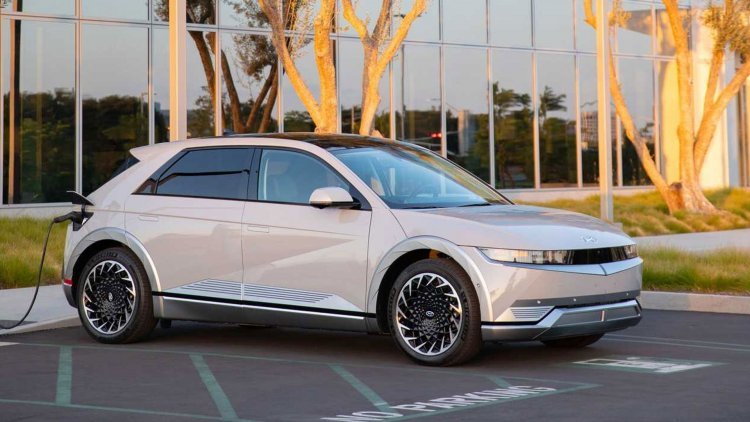Elon Musk notices as Hyundai subtly moves up the EV sales charts
The Hyundai Ioniq 5 and its sibling, the Kia EV6, two new battery-powered vehicles introduced by South Korean automakers earlier this year, smashed sales records and outperformed every other non-Tesla electric vehicle on the market.

The Hyundai Ioniq 5 and its sibling, the Kia EV6, two new battery-powered vehicles introduced by South Korean automakers earlier this year, smashed sales records and outperformed every other non-Tesla electric vehicle on the market. Hyundai and Kia outsold the hot Ford Mustang Mach-E, which was purchased by 15,718 drivers, in the US this year through May with 21,467 sales of these two vehicles.
According to an EV perspective, Joseph Yoon, an analyst with Edmunds, "they're basically just sort of scrubbing the floor." I sincerely don't know if any local retailers have any on hand.
Even while Tesla still sells a lot more cars, it took the business ten years to produce as many electric automobiles as Hyundai and Kia did in a matter of months. Even Elon Musk was impressed.
Hyundai is certainly not a startup. Additionally, according to Steve Kosowski, manager of long-range strategy at Kia America, the design of the current hits began roughly six years ago. When the Chevrolet Bolt first came out, Kia thought about creating a vehicle with a similar size and scope. In the end, something much bigger, sportier, and swankier—at a slightly higher cost—was approved by Kosowski and company.
"The idea was to put together a really big, breakthrough proposition," he says. "With the platform we have and the market insight we have." We're going to declare that Kia is present.
It was at a good time. Due to a rise in both climate concern and gasoline prices, EV adoption is accelerating in the US. There aren't many options available, despite the fact that battery-powered cars are in high demand. Only a limited number of the about 30 models available for purchase on the US market can be purchased for less than $45,000, and the majority of those are very small, out-of-date vehicles like the Nissan Leaf.
Both the Ioniq 5 and the EV6 have the cargo room of a small SUV, a vehicle type that has recently been popular in US garages because to its size and design. Both vehicles use the same modular structure, have identical motors and batteries, and have similar speed ratings. They have fancy screens and among of the fastest charging times in the business, adding about 16 miles of range in a minute in ideal circumstances. Additionally, they include two characteristics that are unusual in the market: pedals for regenerative brake adjustment and bi-directional power (yes, you can run power tools or charge another EV with one of these machines).
They are attracting buyers with lesser budgets who might have otherwise purchased a starting car because they start at under $40,000, claims Yoon at Edmunds. As drivers trade in high-end automobiles with internal combustion engines, they are still luxurious enough inside to attract buyers from the top of the market as well.
According to Yoon, "These two automobiles have sort of arrived at the right price and the appropriate size for a lot of people." And I believe that when a major manufacturer enters the market, there is some sort of natural trust.
When Hyundai's new cars were introduced this winter, Emad Zia and his wife had merely intended to "dip our toes" in the EV market. The two wanted something larger than the Volkswagen Golf R and Mazda Miata in their Dallas garage despite their love of sporty automobiles, ideally with a stick shift. They chose the Ioniq 5 solely on the basis of its appearance and performance specifications, and when they couldn't find the Hyundai for anywhere near the list price, they purchased an EV6.
Emad Zia said, "We're used to having — I don't want to call underdogs — but distinctive cars. And this car's originality and good appearance never go out of style.
According to Kia, only one in ten EV6 buyers had previously owned a plug-in vehicle, and around three out of four EV6 buyers have previously driven a vehicle from a different brand. According to Bloomberg Intelligence, the average transaction price for the EV6 is a few thousand dollars above the sticker price and the waitlist for the vehicle is currently around six months long, indicating that most purchasers are prepared to spend more.
According to Eric Watson, vice president of sales at Kia America Inc., "our dealers are saying that these automobiles are sold within hours."
As first-mover sedans and SUVs grow commonplace even outside of coastal areas, Kosowski claimed that the new Hyundai models are benefiting, in part, from "Tesla fatigue." Hyundai owners are also sticking with what they know; according to Edmunds, of those recently trading in a Hyundai or Kia, over 60% stayed with the brand.
Hyundai is investing $16.5 billion to increase EV production in South Korea and aims to release a new battery-powered vehicle every year for the remainder of the decade. The carmaker aims to sell 3.2 million cars and trucks, or 12 percent of the worldwide EV market, by 2030.
They undoubtedly have an advantage, Yoon claims. Subaru and Toyota need to see if they can catch them.




 admin
admin 




















